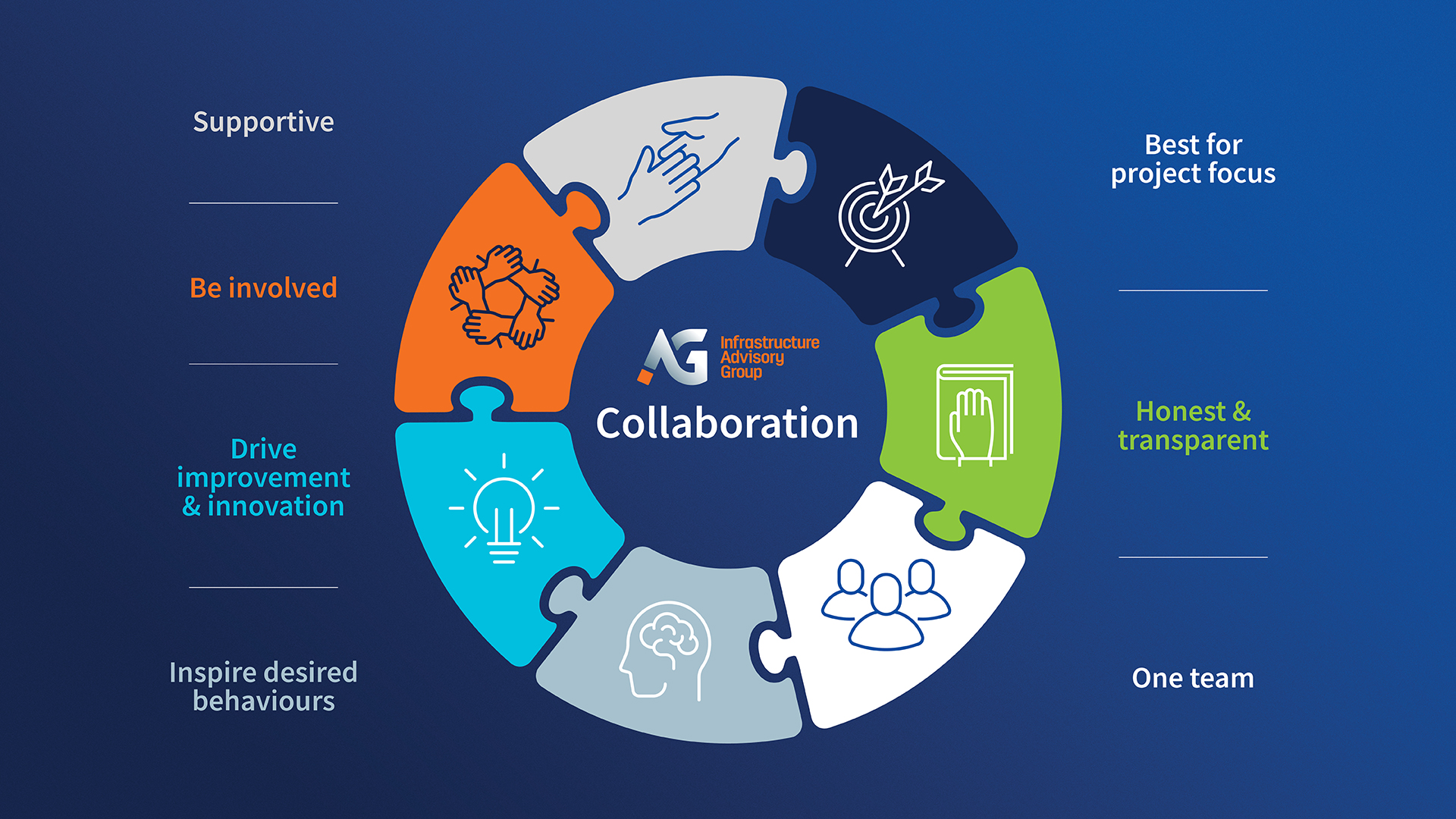IAG Director Jacqui Barker discusses effectively using the active client model on collaborative contracts to deliver best for project outcomes.
There has been much said in recent times about the need for better “true” collaboration on construction projects and how this can positively influence best for project outcomes. There has also been a noticeable shift towards contracts that, at their core, require the contracting parties to work together collaboratively and act in good faith to deliver projects.
However, it takes more than just deciding to work collaboratively and choosing the right contract form. The parties need the right behaviours and mindset as well as a jointly agreed management framework to enable and facilitate collaboration at all levels. To achieve true collaboration, the client must play a more ‘active’ role throughout project delivery, from establishing contracts and processes, to managing performance and proactively resolving issues and realising opportunities. This principle applies no matter what contract form has been entered into.

But what does being an active client actually mean, can it influence project outcomes and are there any downsides? Through our experience on a diverse range of projects some of the fundamentals for an active client are demonstrated via the diagram on the right.
Preparation, Organisation Structure and Readiness
The client plays a significant role in establishing and maintaining the right focus and mindset on a project. Planning for delivery well before the contract is executed is essential. Clients must ensure their own organisation is well positioned through having a deep understanding of the commercial model and the capability, people, process and systems needed to deliver against it. Once a contractor is involved, an effective active client works with the contractor to agree key elements including:
- project organisation structure – clearly defining roles and responsibilities across both organisations and within management, delivery and functional roles, and
- preparing processes, tools, templates etc. for effective project delivery – this is most effective where a project specific approach is developed that acknowledges different organisational needs but strives to minimise overlap or duplication. This includes considering how project organisations approach such tasks as progress tracking, actual costs, accruals, estimate to complete and schedule management.
External factors can significantly alter the needs of a project, so clients in particular should acknowledge this and tailor their approach depending on a whole range of factors. They should also be agile and flexible, remembering one approach does not fit all. However, parties do need to be cognisant of the respective roles and responsibilities and clients shouldn’t be too overbearing, imposing ways of working on the contractor that will inhibit their ability to deliver true value for money and desired project outcomes.
Resourcing
Being an active client means there can be different and greater resource requirements to those under a more traditional model; a client should be aware of potential asymmetry of capabilities and work towards developing capabilities and capacity to be involved throughout the bid or development phase, during negotiation and agreement of commercial terms as well as through delivery For example, where under traditional models during delivery a client’s role is to review progress claimed in payment claims, under collaborative models, an effective active client gets ‘under the hood’, interrogating costs incurred and the forecast cost to complete. This requires a different skillset, that may need to be addressed through recruitment or training of existing resources.
The project team must have the right mix of skills and experience, avoiding any gaps in critical expertise and reducing unnecessary double ups. An effective active client team complements the contractor team’s make-up; whereas having like-for-like structures where client resources shadow contractor resources, or play gatekeeper, may not deliver best for project outcomes. This is even more critical given the current resourcing market, clients need to be careful not to pull delivery resources from industry where they are urgently needed and better placed to enable the contractor to deliver best for project outcomes. Organisations also need to look more long term and put in investment and planning for the sustainable development of capabilities as well as building the right internal culture.
Communication
It’s essential to have good communication between the parties involved with the project but the same is true internally within both organisations.
Both parties must take responsibility to ensure their project teams, senior leaders and other key stakeholders are kept properly informed. This includes having clear lines of communication that encourage openness, transparency and issue sharing. Senior project leaders set the tone in this regard.
Bid or Development Phase and Knowledge of Project
The project team must have a clear understanding of how the overall tender or Target Outturn Cost is built up, including but not limited to, estimates, basis of rate build ups, productivity assumptions, scope inclusions and exclusions and weather allowances. Clients should be fully involved with the development of critical elements throughout the bid phase and utilise external resources such as Independent Estimators to ensure the detail is examined and tested at all stages. It’s also essential that the team and senior leadership from both parties have a clear understanding and agreement of any amendments or additions to the contract including special conditions, specification amendments and compensation / adjustment events. Some of this information can be lost in the throes of finalising an offer; it is beneficial to hold a handover / start-up session with bid and delivery teams to enable a more effective transition. This also sets the project up to manage and share project knowledge throughout delivery.
Relationships and Behaviours
Both parties need to understand what they are trying to achieve, it’s critical that clients move away from their more traditional or adversarial approach, acknowledging that taking on an ‘active client’ role can be a significant shift for the organisation. The desired culture and behaviours have to be supported by the organisation as a whole. Well-intentioned collaboration workshops help define the desired culture and behaviours, but ultimately how these are demonstrated by project and organisational leaders particularly during the early stages is crucial. Key traits of an effective active client are set out in the diagram on the right.

Although clients need to move away from an adversarial approach, it is admittedly not straightforward to effectively strike the balance between supporting, facilitating and challenging. The active client must not become an “over-active” client by being unnecessarily prescriptive or taking over activities or responsibilities that rightly sit with the Contractor as this will run the risk of blurring the lines of responsibility and liability. It may take some time to get the balance right; again, leadership is crucial in this regard.
Fundamentally, true collaboration and achieving best for project outcomes hinges upon the behaviours of the individuals and organisations. The parties must strive to nurture trust and mutual respect at all levels, sharing all project related information and providing full transparency but also understand the need for frank and honest discussions to proactively address and manage issues as and when they arise, regardless of the contract model signed up to. The contract does have a key role to play and the parties should use it as a tool to support the delivery of the project but if it isn’t working they need to work together to look at alternate ways to effectively address an issue – remembering the overall objective is the successful delivery of the project.
Clients need to tread carefully to not be over burdensome on the contractor, create uncertainty around responsibility and liability, contribute to potential delays and additional costs due to the need to be “involved” and ultimately negatively influence a projects success. When effectively applied however the active client model can have a significant positive influence on overall project outcomes with flow on benefits not only for the organisations and individuals involved with the project, but stakeholders and the broader industry as a whole.



